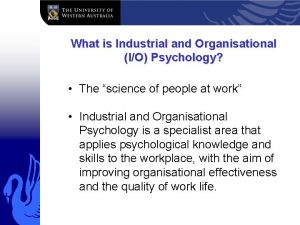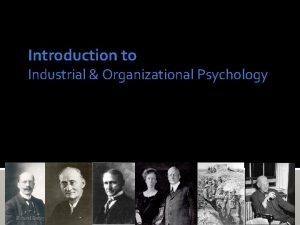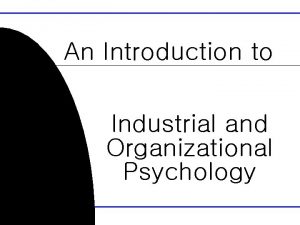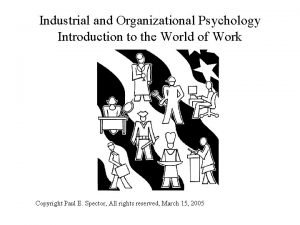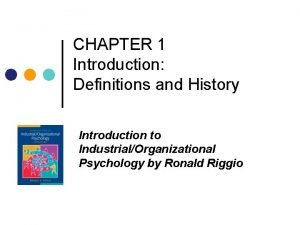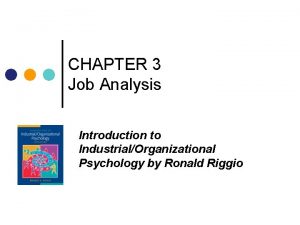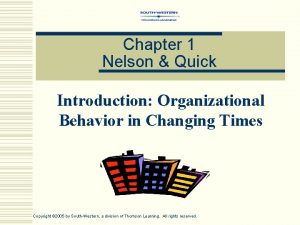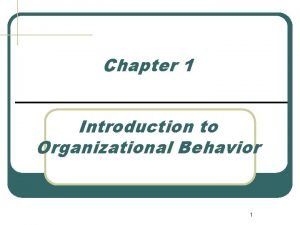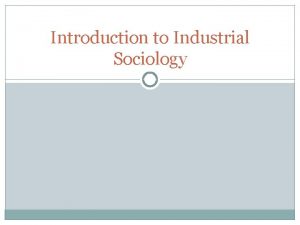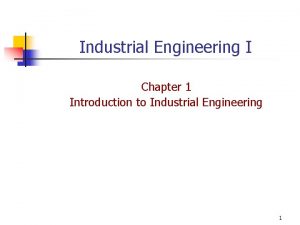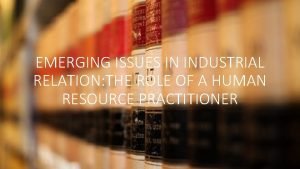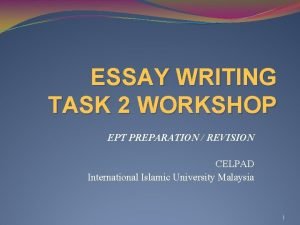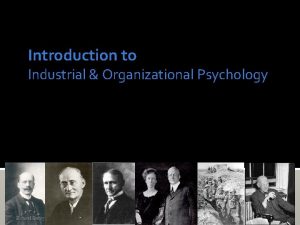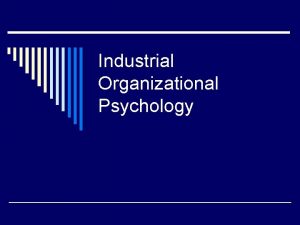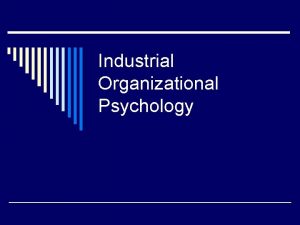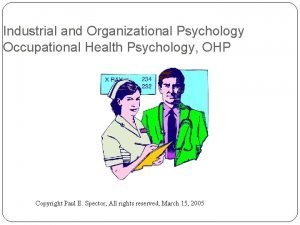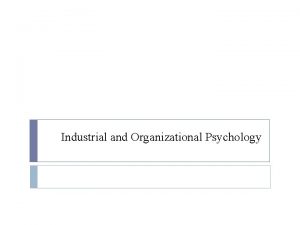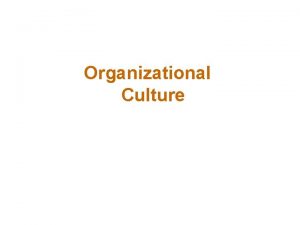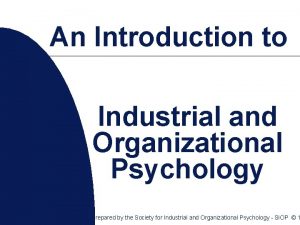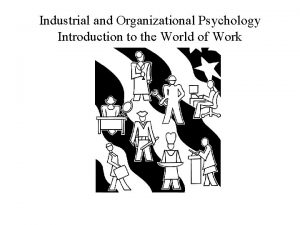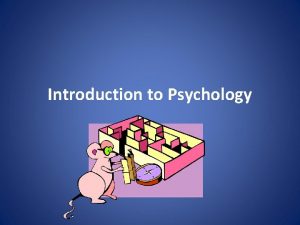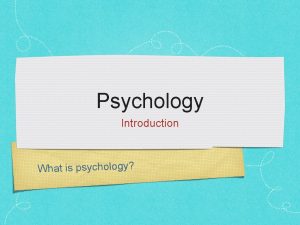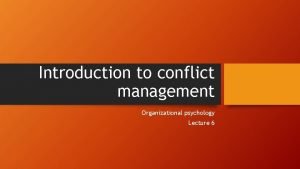Introduction to Industrial Organizational Psychology Lecture Overview v































- Slides: 31

Introduction to Industrial & Organizational Psychology

Lecture Overview v What is I/O Psychology? v I/O Psychology as Profession and Field v History of I/O Psychology

WHAT IS I/O PSYCHOLOGY?

WHAT IS I/O PSYCHOLOGY? Psychology Is the science of the human behavior, cognitions, emotions, and motivation. I/O psychology Add the words “as it relates to work” Dual focus = Organization & Employee Efficiency/productivity of organizations Health/well-being of employees Dual nature = Scientist & Practitioner Application of the science of psychology to the workplace Development/discovery of scientific psychological principles at work

What is I/O Psychology? u. I/O Psychology is: u. The branch of psychology that applies the principles of psychology to the workplace. u. The Purpose of I/O Psychology: u“to enhance the dignity and performance of human beings, and the organizations they work in, by advancing the science and knowledge of human behavior”

Is it important? u http: //www. youtube. com/watch? v=1 FZQ 4_9 -i. LM

Is it important? Typical Day in the life… u. Work u. Commute to work u. Watch TV u. Sleep u. Eat u. Other 8 hours 1 hour 3 hours 8 hours 2 hours

Is I/O Important? � Work and Sleep = Major Life Activities Workers spend the majority of their time doing one or the other � Millions of Americans Work Around 153. 5 million Americans are part of the labor force (BLS. GOV, 2007). I/O psychology can impact all of these individuals, PLUS those around them! �http: //money. cnn. com/magazines/fortune/best- companies/2012/full_list/ � Organizational Effectiveness = Cheaper Goods I/O psychologists can help organizations reduce costs, improve performance/productivity, etc.

I/O AS A PROFESSION u Graduate degree NECESSARY MA or Ph. D. u M. A. required to get a Ph. D. Typically Ph. D. takes 4 -5 years to complete u Content of graduate training u Basic psychology Research methods (heavy emphasis) I/O core content Thesis Dissertation Qualifying Exam Internship, Practica experiences Entry requirements very competitive for Ph. D (somewhat less competitive for Masters) u High GRE Scores, High GPA, Prior Research, 3 Letters of Recommendation SIOP website for most US programs (www. siop. org)

I/O as a Profession Approx. 4% of Psychologists work within the I/O field I/O Related Organizations SIOP – “The Governing I/O Organization” Society for Industrial and Organizational Psychology Division 14 of APA (American Psychological Association) SHRM Society for Human Resources Are I/O’s licensed like clinical psychologists? Little reason to get licensed and has no effect on typical I/O jobs

I/O vs. Business Programs Key Differences I/O psychologists rely on application of psychological principles. I/O psychologists focus on the factors in businesses that affect people. I/O psychologists heavily on research, quantitative methods, and testing techniques for guiding decisions.

MBA Program vs. I/O Program Typical I/O Ph. D Courses • Statistics • Experimental Methodology • Psychometric Theory • Employee Selection and Placement • Organizational Psychology • Employee Training and Development • Performance Appraisal • Job Analysis Typical MBA Courses • Statistics • Business Research • Organizational Behavior • Administrative Policy • Managerial Economics • Financial Management • Marketing Management • Managerial Accounting

Major Activities u Personnel Psychology (The “I” in I/O) Defining and analyzing jobs Recruiting and selecting employees for jobs Training employees Assessing performance Promoting and retaining employees Test development and Validation Legal Issues u Organizational Psychology (The “O” in I/O) Determining how people feel about work Determining why people act as they do at work Examining the effects work has on people Examining the effects people have on one another How organizations are structured and function How work is designed Tool and equipment usage on the job Examining work relevant health, safety, and well-being issues

I/O AS A PROFESSION u Employment Little or no unemployment (usually) 4 Main Work Settings: u Universities u Consulting Firms u Industry/Corporations u Government Agencies Field expanding and becoming more popular I/O psychologists often work/consult with u MBAs u CEOs, u VPs, u HR staff u Healthcare/Health Science Staff (if in Occupational Health Specialty)

I/O AS A PROFESSION

M. A. ’s – Employment Settings Education Chart Other Title 7% Consulting 37% 1% Private Sector 44% Public Sector 11%

Ph. D. ’s – Employment Settings Other Chart Title 4% Consulting 25% Public Sector 8% Private Sector 23% Education 40%

Salaries of I/O Psychologists in the US Mean Salaries 2009 Median Salaries 2009 M. A. $88, 000 Ph. D. $125, 000 Top 10% $200, 000 or more Professors $94, 000 Consultants $106, 717 New Ph. D. $83, 307 Men Ph. D. $132, 000 Women Ph. D. $106, 957 Note: Data taken from 2009 SIOP Income Survey

SIOP Activity Go to web site of the Society for Industrial- Organizational Psychology (SIOP) at http: //www. siop. org Click on “WHAT IS I/O” and read: Go to the SIOP Job. Net and click on “Positions Available”. Assuming you had the proper training and credentials discuss the 2 open positions you would find most intriguing and why.

The History of I/O

History of I/O u Early Years (1900 s) u World War I (1914 -1918) u Between the Wars (1919 -1940) u World War II (1941 -1945) u Toward Specialization (1946 -1963 u Government Intervention (1964 -1993) u Information Age (1994–Present)

Early 1900 s Merging of two forces: Applying psychology & industrial engineers improving efficiency Four Major Figures u. Walter Dill Scott “Psychology of Advertising” 1908 “Increasing Human Efficiency” Contributed WWI to application to Army

Early 1900’s u Frederick Taylor Engineer focused on redesigning work “Principles of Scientific Management” 1911 Four Principles u. Science over rule of thumb u. Scientific selection and training u. Cooperation over individualism u. Equal division of work best suited to management and employees Known for institutionalizing forced breaks for those handling heavy iron (half the cost, 3 times the production)

Early 1900’s u Lillian (and Frank) Gilbreth Lillian - Focused on Stress and fatigue on workers Frank - Focused on technical aspects of worker efficiency - Lillian’s 1908 speech – called for attention to person element Time & Motion Studies, “therblig” Later – invented things like foot pedal trashcan “Cheaper by the Dozen”

Early 1900’s u Hugo Munsterberg Considered the “Father of Industrial Psychology” “Psychology and Industrial Efficiency” 1913 Trolley Car Simulator Creation u. Systematically studied all aspects of job through observations u. Studied what makes good operator u. Analyzed behaviors and asked questions u. Basically, he pioneered Job Analysis

World War I (1914 -1918) u Army Alpha Project (1914 – 1918) – Army hires psychologists including Robert Yerkes Screen recruits for intelligence Army Beta – created for those that were illiterate (30%) u Journal of Applied Psychology (1917) – first I/O journal Documented Army Alpha & Beta projects Still most prestigious journal in the field

Between the Wars (1919 -1940) u James Cattell (1921) forms Psychological Corporation to provide services to industry u Hawthorne Studies (1924) Research by Harvard & MIT Led by Elton Mayo Conducted at Hawthorne Plant of Western Electric Co. Looking for cost effective ways to reduce expenses adjusted lighting levels Key Finding▪ Found impact of intervention on employee performance was a result of the intervention itself. Hawthorne Effect ▪ Novelty of intervention influences behavior (i. e. , I observe you working, and you perform better because of my presence as an observer)

World War II (1941 -1946) u. Army hires I/O psychologists to select & classify recruits u. Army General Classification Test (AGCT) Group testing, sorted applicants into 5 categories based on if they could learn duties, etc

Post World War II u Toward Specialization (1946 -1963) u Government Intervention (1964 -1993) u Information Age (1994–Present) Evolved into legitimate area of practice, schools, terminology, etc Civil Rights Act of 1964 – Protected Classes (Gender, Race, Ethnicity Equal Employment Opportunity Commission Court Cases (e. g. , Griggs vs Duke Power, Dothard vs Rawlinson) Higher demands for organizations and employees Greater and more frequent technology improvements More complex, computer generated statistical analyses are becoming common (MANOVA, Multilevel Modeling, Structural Equation Modeling, Item Response Theory, etc. ) Application of cognitive psychology to I/O, specifically performance appraisal Increased focus on selection methods (selecting the “right person” for the job is becoming more important) Globalization has become an important issue

Reflection Question Having reviewed the History of I/O and the current state of the field, where do you think the field will be in 20 years? Think of organizational, economic, and governmental factors that may affect the field in the next 20 years. There are no wrong answers to this question.

Next Time Research in I/O
 Psy 3024 ucf
Psy 3024 ucf Industrial organizational psychology
Industrial organizational psychology Introduction to psychology lecture
Introduction to psychology lecture Siop jobnet
Siop jobnet Introduction to industrial psychology
Introduction to industrial psychology 01:640:244 lecture notes - lecture 15: plat, idah, farad
01:640:244 lecture notes - lecture 15: plat, idah, farad Social psychology lecture
Social psychology lecture Forensic psychology lecture
Forensic psychology lecture Aim of health psychology
Aim of health psychology What is bioinformatics an introduction and overview
What is bioinformatics an introduction and overview Introduction product overview
Introduction product overview Introduction product overview
Introduction product overview Introduction product overview
Introduction product overview Introduction product overview
Introduction product overview History of organizational psychology
History of organizational psychology History of organizational psychology
History of organizational psychology Introduction to biochemistry lecture notes
Introduction to biochemistry lecture notes Introduction to algorithms lecture notes
Introduction to algorithms lecture notes Job analysis introduction
Job analysis introduction Branches and fields of psychology
Branches and fields of psychology Positive psychology ap psychology definition
Positive psychology ap psychology definition Examples of altruism
Examples of altruism Social psychology ap psychology
Social psychology ap psychology Introspection method
Introspection method Social psychology is the scientific study of
Social psychology is the scientific study of Health psychology definition ap psychology
Health psychology definition ap psychology Organizational behavior chapter 1
Organizational behavior chapter 1 Organizational behavior chapter 1
Organizational behavior chapter 1 Definition of industrial sociology
Definition of industrial sociology Industrial engineering approach
Industrial engineering approach Introduction to industrial relations
Introduction to industrial relations Ept essay examples
Ept essay examples

